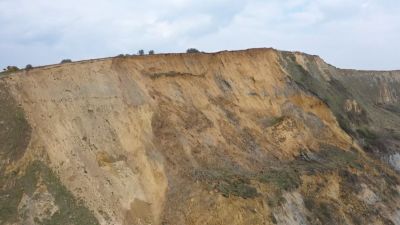Jurassic Coast sees biggest rockfall in decades as chunk of cliff blocks beach

People are being warned to stay away from a cliff edge and beaches in Dorset after a huge rock fall completely blocked off the beach.
A 300m section of the Jurassic Coast cliff face has fallen between Seatown and Eype Beach - and Dorset Council is warning further movement is expected due to fresh cracks.
The rockfall has been described as the biggest in 60 years as the sandstone cliff has collapsed and caused boulders the size of cars to plummet near Seatown in Dorset.
Dorset Council says it will monitor the situation during the next few weeks but is warning people to stay away from the edge.
It said: "Now the ground is drying out, there is the possibility of more slips and falls and they can happen very quickly. For your safety keep clear of tops and bases of cliffs when out and about."
The path has been cordoned off and the council is working with the National Trust to use rope and chain to guide people away from the edge.
The statement added: "Please take notice of safety signs and stay off slip material on the beach. Keep away from cliff edges and bases."
What causes a large cliff fall?
ITV West Country's weather presenter and meteorologist Charlie Powell explains:
Cliff falls and landslides are more to do with the rock type than anything else. Layered rocks or lots of clay do not make for very good foundations and if something undermines a section of the rock structure, causes it to fail or weaken, then it will slump or slide.
It is a bit like an avalanche, where an unsteady or weaker layer becomes dislodged or unstable and starts to move.
Geologically this is mostly down to erosion from the sea or the weather, but it can be down to hard engineering too close to the cliff edge, where excess weight destabilises the rock structure and cause it more strain.
Otherwise, the wind and the sea just wear away notches at the base of the cliff making it top heavy and causing it to fall down. Alternatively saturated ground can also make the rock unsteady, but during cold weather water can also freeze in tiny pores and gaps, expanding and fracturing the structure.
So there's a lot of causes and effects, mostly natural but nearly always dramatic.
Read more: